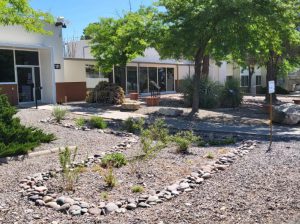 Pollinators play a crucial role in both human agriculture and ecosystems by supporting thousands of plant species and crops which feed humans and livestock. Unfortunately, habitat loss, disease, and pesticides contribute to the decline in pollinator biodiversity worldwide, which has led to a substantial reduction in native bee species, impacts to honeybees, and the decline of the iconic Monarch Butterfly. In their efforts to integrate sustainable design, several NASA centers have implemented measures promoting preservation of pollinator habitats though gardens, meadows, and other initiatives.
Pollinators play a crucial role in both human agriculture and ecosystems by supporting thousands of plant species and crops which feed humans and livestock. Unfortunately, habitat loss, disease, and pesticides contribute to the decline in pollinator biodiversity worldwide, which has led to a substantial reduction in native bee species, impacts to honeybees, and the decline of the iconic Monarch Butterfly. In their efforts to integrate sustainable design, several NASA centers have implemented measures promoting preservation of pollinator habitats though gardens, meadows, and other initiatives.
To enhance New Mexico’s natural beauty, four pollinator gardens were planted in 2022 on the south sides of B100 and B101 and at the main entrances to the cafeteria and rotunda. They were created to mitigate some function of the natural landscape that was offset to build the Center. These gardens also help to educate visitors on the beauty and names of surrounding desert flora and provide a peaceful place to sit and view the garden, the Jornada del Muerto, and mountains in the distance.
The native plants are drought resistant, hardy, and attract bees, butterflies, hummingbirds, and other pollinators. There are plans to install a trail camera at one of the garden sites to identify some of the visiting pollinator species. The Center also wants to register the gardens as wildlife habitats through the National Wildlife Federation and Monarch Waystations.






